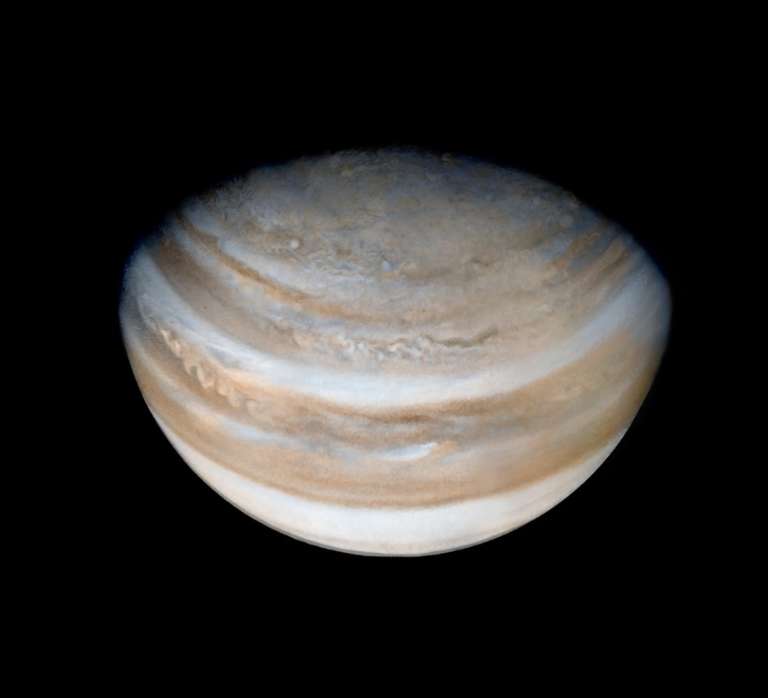Pioneer 10 and 11, outer solar system explorers
Highlights
- NASA’s Pioneer 10 mission launched on March 2, 1972, followed by Pioneer 11 on April 5, 1973.
- Pioneer 10 is credited with being the first spacecraft to traverse the asteroid belt and fly by Jupiter. Pioneer 11 was the first probe to do a flyby of Saturn.
- Pioneer 11’s mission ended in 1995. Pioneer 10 sent its last signal to Earth in 2003.
NASA’s Pioneer 10 and 11 were twin probes that helped illuminate the outer stretches of our solar neighborhood.
Though the missions launched about a year apart and had different trajectories, together they accomplished a number of historical feats: Pioneer 10 provided unprecedented insight into the asteroid belt and performed the first flyby of Jupiter, while Pioneer 11 was the first spacecraft to perform a flyby of Saturn.
NASA no longer has contact with either spacecraft, but both probes have continued to voyage deeper into space. Both Pioneer 10 and 11 are on trajectories that will eventually take them out of the solar system entirely, each carrying a map back to Earth should any intelligent life ever intercept them.
When did Pioneer 10 and 11 launch?
Pioneer 10 took off from the Kennedy Space Center (KSC) in Cape Canaveral Florida on March 2, 1972. Pioneer 11 followed soon after, launching from KSC on April 6, 1973. Both spacecraft flew on Atlas-Centaur launch vehicles.

What did Pioneer 10 and 11 do?
Pioneer 10 began breaking records shortly after launch. As it zipped toward Jupiter, it became the first spacecraft to ever venture beyond Mars. Then, on July 15, 1972, the spacecraft entered the asteroid belt — a swath of rocky material that spans about 280 million kilometers (175 million miles) in width. The probe passed through the region, becoming the first spacecraft to ever do so.
Pioneer 10 reached Jupiter on December 3, 1973. It took the first up-close, detailed pictures of the gas giant and made observations about its radiation belts, magnetic field and more. After completing its primary mission, Pioneer headed in the direction of the star Aldebaran, which it’s expected to reach in roughly 2 million years.
Pioneer 11 flew through the asteroid belt in 1974, just a few years after its counterpart. Pioneer 11 needed a gravity assist from Jupiter in order to reach Saturn, which allowed for it to get closer to Jupiter than any spacecraft ever before. As a result, Pioneer 11 beamed back the first images of Jupiter’s polar regions, as well as stunning photos of the Jovian moons.
On September 1, 1979, Pioneer 11 came within 21,000 kilometers (13,000 miles) of Saturn — the first time a spacecraft had approached the planet this close. In addition to discovering Saturn’s F ring, Pioneer 11 spotted two new moons.
After its rendezvous with Saturn, Pioneer 11 sped off toward the center of the Milky Way — a one-way course it remains on to this day.

Plaques on board Pioneer 10 and 11
Both Pioneer 10 and 11 contain gold-anodized aluminum plaques that serve as a peaceful message to extraterrestrial life that could someday encounter the spacecraft. The Planetary Society’s co-founder, Carl Sagan, helped conceive and design the plaques.
The metal plates depict a naked man and woman in addition to diagrams showing the location of the Sun and Earth relative to pulsars, which serve as cosmic landmarks. This way, if intelligent life ever finds the probes, they could find and make contact with the people of our planet.
The Pioneer plaques were predecessors to the Golden Records that flew on NASA’s Voyager 1 and 2 missions.
The Pioneer Anomaly
When the Pioneer missions had reached the outer solar system, scientists noticed the spacecraft were falling behind their projected trajectories by about 5,000 kilometers (3,000 miles) each year. No one knew why; in fact, some chalked it up to a gap in our understanding of physics.
After NASA declined to fund research that could shed light on the so-called “Pioneer Anomaly,” Jet Propulsion Laboratory scientist John Anderson and his colleague, physicist Slava Turyshev, contacted The Planetary Society for help. The Planetary Society successfully raised enough money from its members to support the research that eventually solved the Pioneer Anomaly.
Researchers ultimately concluded that the Pioneer Anomaly was the result of anisotropic thermal radiation — essentially, heat radiating from the spacecraft unevenly in many directions was causing them to slow down.
"Without the rescue of the Doppler data, we would have been blind, never able to claim the quantitative data we need to solve the anomaly,” said Slava Turyshev. “The recovery of Doppler and telemetry data and the entire effort in thermal analysis would not have happened without the Planetary Society."
The legacy of Pioneer 10 and 11
Though it launched second, Pioneer 11’s mission ended first. The probe transmitted its final signal to Earth in 1995; Pioneer 10’s last signal was detected in 2003.
The Pioneer missions are credited with laying the foundation for future NASA missions, including Voyager 1, Voyager 2, Cassini and more. Given their many discoveries and daring firsts, the Pioneer missions were true trailblazers that fulfilled their namesake.
Support missions like Pioneer 10 and 11
Whether it's advocating, teaching, inspiring, or learning, you can do something for space, right now. Let's get to work.


 Explore Worlds
Explore Worlds Find Life
Find Life Defend Earth
Defend Earth



